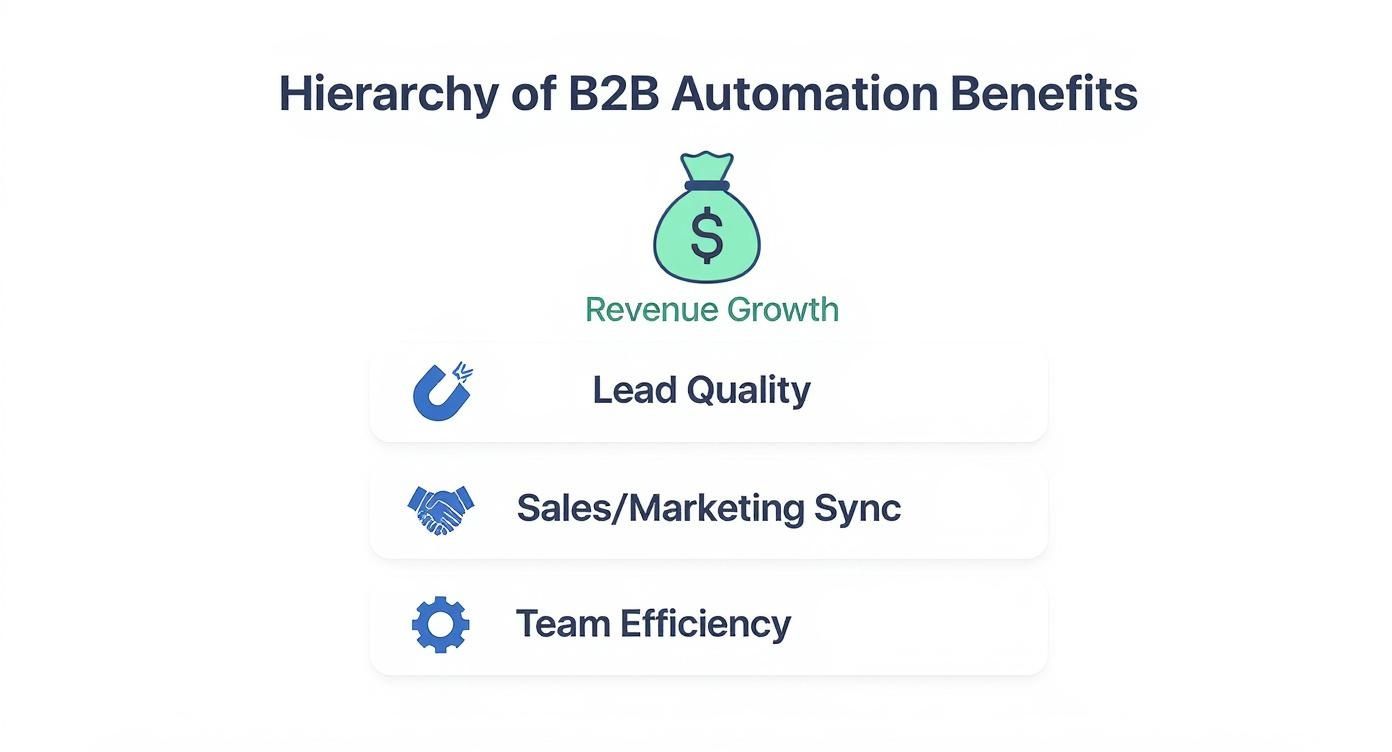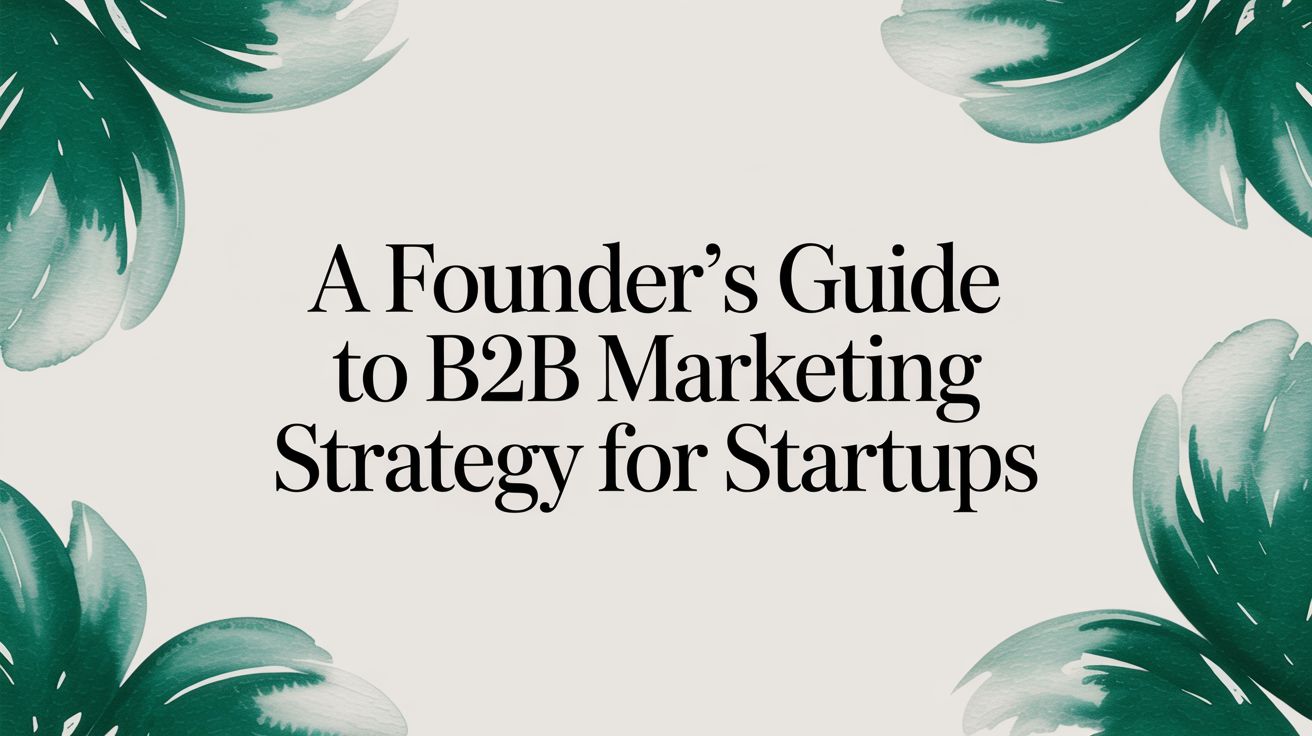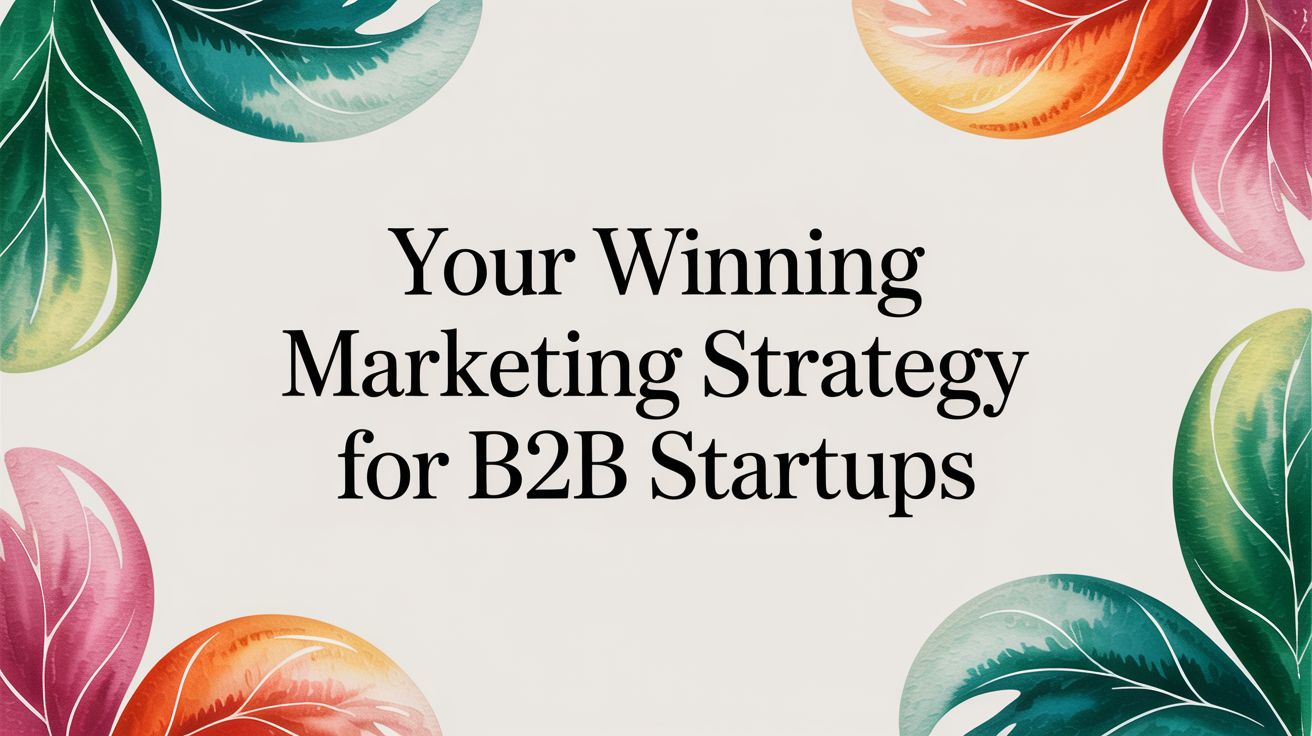B2B Marketing Automation Platforms Explained
October 30, 2025

Imagine having a brilliant marketing strategist on your team—one who works 24/7 to orchestrate every campaign, nurture every lead, and capture critical data without ever needing a break. That's what a B2B marketing automation platform brings to your business.
This guide will demystify the technology, moving past the jargon to show you what these platforms actually do and how they drive real business growth.
The Engine Room of B2B Growth

Think of a B2B marketing automation platform as the central nervous system for all your marketing efforts. It’s the smart hub that connects what were once separate activities—like emails, social media posts, and website visits—into one intelligent, cohesive system. This unified view isn't just a nice-to-have; it's essential for modern B2B growth.
This technology is purpose-built to handle the long, complex sales cycles that are standard in the B2B world. Unlike simpler email tools, these platforms are designed to manage relationships with multiple decision-makers inside a single company, often over months or even years.
The Core Purpose of Automation
At its heart, the goal is simple: deliver the right message to the right person at exactly the right time.
This transforms your marketing from a series of disconnected, manual campaigns into a powerful engine for sustainable growth. Instead of juggling spreadsheets and one-off emails, you build automated journeys that guide prospects from their first flicker of interest all the way to becoming loyal clients.
This creates a profound shift in how you engage with your target accounts, delivering a few key benefits:
- Deeper Personalization: You can finally engage prospects with content that speaks directly to their role, their pain points, and where they are in the buying process.
- Smarter Efficiency: Repetitive tasks get automated, freeing up your team to focus on high-impact strategy and creative thinking.
- Data-Driven Decisions: You gain crystal-clear insights into what’s working, what isn't, and how your customers actually behave.
The strategic importance of this is undeniable, with 98% of B2B marketers now considering automation crucial for success. The global market, valued at USD 6.65 billion in 2024, is expected to skyrocket to USD 15.62 billion by 2030. These aren't just trends; they're the new standard for B2B marketing.
By bringing one of these platforms into your business, you’re not just buying software; you’re building an operational backbone. This empowers your team to manage intricate, multi-channel campaigns with precision and scale, ensuring your website is at the heart of B2B marketing growth.
Why Top B-to-B Companies Use Automation
The decision to bring a B2B marketing automation platform into your business isn’t about chasing the latest shiny object. It’s a fundamental shift in how you operate. You’re moving away from casting a wide, hopeful net and instead adopting a precision-guided system that finds and cultivates real business opportunities. That shift delivers tangible results that fuel growth, boost efficiency, and strengthen your bottom line.
Right at the top of the list is a dramatic improvement in lead quality. In the B2B world, not all leads are created equal. Automation is what allows you to build sophisticated lead scoring models that watch a prospect’s every move—from downloading a whitepaper to lingering on your pricing page—and assign a score based on how ready they are to talk.
This means that when a lead finally lands in a salesperson’s queue, it’s not a cold contact. It's a warm, informed prospect who has already signaled genuine interest.
Unifying Sales and Marketing
One of the most powerful outcomes of getting automation right is its ability to finally build a sturdy bridge between sales and marketing. For far too long, these teams have operated in their own worlds, leading to friction, finger-pointing, and a ton of missed opportunities. Automation smashes those silos by creating a single, shared view of every prospect and customer.
Sales can instantly see a lead’s entire marketing history, giving them invaluable context for their conversations. This shared intelligence turns two separate functions into a single, unified revenue team. If you want to dive deeper into this, you can learn about the importance of aligning sales and marketing goals in our detailed guide.
This alignment is a major reason the technology is seeing such widespread adoption. Today, 51% of companies are using B2B marketing automation platforms, and that includes 47% of small businesses. The push is all about the clear wins: better lead nurturing, tighter team alignment, and the power to personalize customer experiences at a scale that was previously impossible. For a closer look, you can explore the complete findings on B2B automation adoption.
Driving Efficiency and Proving Value
Beyond just better leads, automation frees your team from the soul-crushing, repetitive tasks that eat up so much time. Think about all the hours spent manually sending follow-up emails, segmenting lists for the tenth time, or scheduling social media posts. Automation handles all of that without getting tired or bored, freeing up your marketing pros to focus on what humans do best: strategy, creativity, and building actual relationships.
This shift isn't just about doing more with less; it's about reallocating your most valuable resource—your team's brainpower—to high-impact work that truly moves the needle.
Finally, these platforms deliver the one thing marketing departments have always struggled to produce: crystal-clear, data-backed ROI. By tracking every touchpoint from the very first click to the final sale, you can draw a straight line from a specific marketing campaign to the revenue it generated. This transforms marketing from a perceived cost center into a proven engine for growth, demonstrating its undeniable value to the entire organization.
Must-Have Features in Your B2B Platform
Picking a B2B marketing automation platform can feel a bit like walking into a massive hardware store for the first time. Every tool on the shelf promises to solve a different problem, but which ones will actually help you build your business?
For B2B companies, where sales cycles are long and relationships are everything, you can't just grab a random assortment of gadgets. You need a specific set of tools designed to build and run a powerful growth engine. Let's break down the features that truly matter.
The Operational Core: Automation and Integration
The real magic of these platforms is their ability to run sophisticated, personalized campaigns on autopilot. You need to look for advanced email marketing and workflow automation. This lets you build out multi-step journeys that react to what your prospects do.
Think about it: when someone downloads a whitepaper, that shouldn't just trigger a generic "thanks for your download" email. It should kick off a tailored email sequence that nurtures their interest, guides them to the next logical piece of content, and gently moves them toward a sales conversation.
Of course, this automation is useless if it's trapped in its own little world. That's why robust CRM integration is completely non-negotiable. This is the feature that finally breaks down the walls between marketing and sales. It creates a single, unified view of every single touchpoint a customer has with your company. Without it, you’re just running two separate systems that happen to have the same logo.
If you’re just starting to build out your tech stack, getting a handle on the different B2B CRM software options is a critical first step.
The infographic below shows how these integrated features drive the benefits that your CEO actually cares about—from improving the quality of leads to making the entire business more efficient.

As you can see, all roads lead back to revenue. Better leads, aligned teams, and smoother processes aren't just nice-to-haves; they are the direct inputs for a healthier bottom line.
Capturing Leads and Proving Impact
Your automation system needs a way to feed itself fresh prospects. This is where integrated landing page and form builders become essential. These tools empower your marketing team to spin up and launch campaigns quickly, capturing lead info without having to get in line for developer support.
Finally, none of these efforts mean a thing if you can't measure the results. You absolutely need detailed analytics and reporting that provides clear, honest insights into campaign performance, lead conversion rates, and the holy grail of B2B marketing: revenue attribution.
Great reporting answers the one question every B2B marketer gets asked: "Which of our marketing activities are actually generating sales?" This ability to prove ROI is what transforms marketing from a cost center into a documented growth driver.
To make this crystal clear, the table below breaks down exactly how these core features solve the real-world challenges that B2B marketers face every day.
Core B2B Marketing Automation Features and Their Impact
Here’s a simple breakdown of the essential platform features and how each one directly addresses a critical B2B marketing challenge. This should help you prioritize what to look for during your selection process.
By focusing on these four pillars—lead management, CRM integration, lead capture tools, and powerful analytics—you ensure you're not just buying software. You're investing in a system that can fundamentally change how you attract, engage, and win new business.
How to Choose the Right Automation Partner
Picking a B2B marketing automation platform isn't just another software purchase. It’s a long-term commitment. Seriously. The right choice can become one of your most powerful growth partners, but the wrong one will lead to nothing but frustration, wasted cash, and stalled progress.
This decision requires a strategic approach that goes way beyond a slick sales demo or an impressive list of features.
Before you even think about looking at vendors, you need to look inward. An honest internal needs assessment is the most critical first step you can take. You absolutely must have a clear picture of your own organization's reality before you schedule a single demo.
This means asking some tough questions. How technically skilled is your team, really? Is your sales process fairly straightforward or a complex web of handoffs and interactions? What are your genuine growth goals for the next one, three, and five years?
Getting straight answers to these questions first creates a realistic scorecard you can use to measure every potential platform.
Evaluating Potential Partners
Once you have a clear picture of what you actually need, you can start assessing vendors with confidence. Your evaluation should be built on four key pillars that will ultimately determine your long-term success. Think of these as the non-negotiables.
- Ease of Use: A platform with all the bells and whistles is useless if your team finds it too confusing to operate. Look for an intuitive interface that empowers your marketers, not one that requires a dedicated specialist just to run a simple campaign.
- Customer Support: When you inevitably run into a technical snag or need some strategic advice, how responsive and helpful is their team? Check reviews, but also ask for references to get a real sense of their support quality.
- Integration Capabilities: This is a big one. Your automation platform has to play nicely with your existing tech stack, especially your CRM. Poor integration creates data silos and completely undermines the point of having a unified system in the first place.
- Pricing Transparency: Watch out for vendors with confusing or hidden fees. A true partner will offer clear, scalable pricing that grows with your business, not one that penalizes your success with unexpected overage charges.
The goal is to find a platform that feels like an extension of your own team. You're not just buying a tool; you're investing in a system and a support network designed to help you achieve your most ambitious goals.
Ultimately, the right partner is one that understands your unique business challenges and has a vested interest in your success. While a platform's features are important, it's the strength of the partnership that will truly determine your return on investment.
If you're exploring how outside experts can help steer this process, understanding the value of an agency for B2B marketing can add another layer of clarity to your strategy. By asking the right questions and prioritizing these core criteria, you can move past the sales pitch and select a partner that will fuel your growth for years to come.
Implementing Your Platform for Immediate Wins

Getting the keys to a powerful B2B marketing automation platform is a huge milestone. But the real work starts now. A smart, phased rollout is what separates a tool that gathers digital dust from one that becomes the engine of your growth strategy. The goal isn't to boil the ocean with a massive, complex launch; it's to score quick, meaningful wins that build momentum and prove the platform's value right out of the gate.
This process doesn’t start with software, it starts with your data. Before you even think about migrating a single contact, you have to get serious about cleaning up and organizing your existing database. Think of it like pouring the foundation for a new house—if you skip this step, you’re just building problems into the structure from day one.
Building Early Momentum
Once your data is in good shape, resist the urge to automate everything all at once. The best move is to kick things off with a small, tightly focused pilot project. You want to design this first campaign for a quick and visible win that shows off the platform's power to key people in the company.
For instance, you could build a simple lead nurturing sequence for everyone who attended a specific webinar. This kind of self-contained project lets your team learn the ropes in a low-risk environment while delivering tangible results you can actually measure. These early victories are absolutely essential for getting people excited and securing long-term buy-in across the organization.
A successful implementation is less about technical perfection and more about human adoption. If your sales and marketing teams don’t understand the “why” behind the platform, they will never fully embrace it.
This is where training is non-negotiable. Your implementation plan needs dedicated sessions for both marketing and sales. Don’t just show them how to use the software; show them how it will make their jobs easier and help them hit their numbers. Frame it as the tool that finally delivers better leads to sales and proves marketing’s direct contribution to revenue.
Defining Your Rules of Engagement
Before you flip the switch, there are two critical rulebooks you need to write: your lead lifecycle and your scoring model. These frameworks are the internal logic that will govern your entire automation engine.
- Lead Lifecycle Definition: Get sales and marketing in a room and map out the exact journey a prospect takes. Define the precise stages, from a raw lead to a marketing-qualified lead (MQL), and finally, to a sales-accepted opportunity. This creates a shared language and eliminates the friction between the two teams.
- Initial Scoring Model: Put together a baseline point system that helps you spot your most engaged prospects. Assign points for key behaviors (like visiting the pricing page) and demographic info (like job title or company size). You'll tweak this model over time, but starting with a solid framework is key.
By following this strategic roadmap—clean data, a focused pilot project, great training, and clear internal rules—you can sidestep the common traps that derail so many marketing automation projects. This approach ensures you're not just launching a piece of software; you're firing up a powerful new engine for growth and will start seeing a return on your investment almost immediately.
The Future of B2B Marketing Automation
The world of B2B marketing automation is getting a serious upgrade, and it’s all thanks to Artificial Intelligence. This isn’t some far-off, sci-fi concept; it’s happening right now, reshaping how we build smarter, more authentic connections with our clients. AI is shifting from a simple task-doer to a genuine strategic partner for marketers.
Think about a system that doesn't just score leads based on what they've already done. Imagine one that predicts future buying behavior with startling accuracy. That's predictive lead scoring in a nutshell, and it’s allowing sales teams to connect with the right accounts at the exact right moment. AI is also set to orchestrate hyper-personalized content journeys that shift on the fly based on a prospect's evolving needs.
Smarter Systems and Deeper Relationships
This shift is changing the very nature of our work. The game is no longer just about managing campaigns; it’s about conducting the entire customer experience across every touchpoint—not just email.
Here are a few of the key advancements steering us into the future:
- Dynamic Campaigns: Marketing efforts will automatically tweak messaging and offers based on real-time customer actions, keeping every interaction as relevant as possible.
- Advanced ABM: AI is getting much better at pinpointing high-value accounts and the key decision-makers within them, making account-based marketing more precise than ever.
- Predictive Analytics: We're gaining the ability to see which strategies are most likely to drive revenue, which means we can finally put our budgets where they'll make the biggest impact.
This move toward intelligent automation is fueling massive industry growth. In 2023, the B2B marketing automation market was valued at USD 4.7 billion, but it’s projected to explode to USD 15.2 billion by 2033. You can explore the full B2B marketing automation market projections to see the numbers behind this trend.
The next generation of B2B marketing automation isn't about replacing the human element; it’s about amplifying it. These tools will free marketers from operational burdens to focus on strategy, creativity, and building genuine client relationships.
This positions marketing teams to become true leaders within their organizations. By getting on board with these changes, you can go from feeling overwhelmed to gaining a real operational edge. For a deeper dive, check out our guide on how AI in B2B marketing is creating new opportunities.
Final Thoughts & Frequently Asked Questions
As you get closer to choosing a platform, a few common questions usually pop up. Let's tackle them head-on, based on what we see in the field.
What's the Real Difference Between B2B and B2C Platforms?
It really all boils down to the sales cycle.
B2B marketing automation platforms are purpose-built for the long haul—think complex, multi-stage deals with a whole committee of decision-makers. They're heavy on features like account-based marketing (ABM), deep CRM integration, and nuanced lead scoring to help you manage those intricate, high-value relationships.
B2C platforms, on the other hand, are designed for a much faster, higher-volume game. They're geared toward individual buyers and quick transactions, so their toolkits are packed with e-commerce integrations, mass personalization tools, and social media features to drive immediate purchases.
How Long Does It Actually Take to See an ROI?
This is the million-dollar question, and while it varies, there's a predictable pattern. You'll likely see the first wave of benefits within 3-6 months of a solid implementation. These aren't necessarily huge revenue jumps yet, but they're crucial early wins: better lead quality, sales and marketing teams that are finally on the same page, and a noticeable uptick in efficiency.
The more significant financial return—the kind you can measure in revenue growth and shorter sales cycles—typically becomes clear within the first 12 months. That's the point where your team has really hit its stride with the platform, and you're continuously optimizing your campaigns based on real data.
Is This Stuff a Good Fit for Small Businesses?
Absolutely. The old idea that marketing automation is just for giant enterprises is a complete myth today. The market is now full of powerful, affordable B2B marketing automation platforms designed specifically with small and mid-sized businesses (SMBs) in mind.
These tools offer flexible, scalable pricing, user-friendly interfaces, and all the core features you need to perform well above your weight. This has leveled the playing field, allowing companies of any size to build sophisticated, meaningful client relationships that fuel real growth.
Ready to build a marketing strategy that drives real revenue? As a Fractional CMO and product marketing specialist, Big Moves Marketing helps B2B SaaS and AI startups launch with confidence. Let's create the positioning and sales tools you need to win deals. Learn more about how we can work together.
%20-%20Alternate.svg)


%20-%20white.svg)